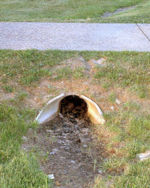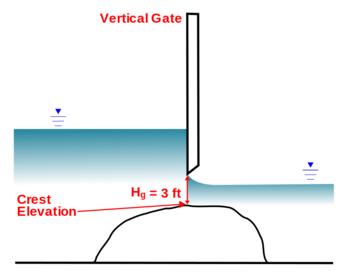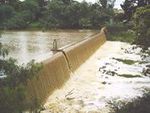SMS:SRH-2D Structures: Difference between revisions
(→Gate) |
No edit summary |
||
| Line 5: | Line 5: | ||
* The two arcs '''''must be ordered in the same direction''''' (i.e. left to right as looking downstream). If this is not the case, model results are will not represent the structure. | * The two arcs '''''must be ordered in the same direction''''' (i.e. left to right as looking downstream). If this is not the case, model results are will not represent the structure. | ||
* In the region of structures that represent one dimensional flow (Weir, Culvert, Gate) the two dimensional flow is disabled. SRH-2D will identify cells/elements enclosed by the upstream and downstream structure definitions (connecting the end points of the arcs/nodestrings) and disable the elements. In order to make the display in SMS match what the model is doing, the user will generally create this polygon in the material coverage and assign the area to the disabled material type. | * In the region of structures that represent one dimensional flow (Weir, Culvert, Gate) the two dimensional flow is disabled. SRH-2D will identify cells/elements enclosed by the upstream and downstream structure definitions (connecting the end points of the arcs/nodestrings) and disable the elements. In order to make the display in SMS match what the model is doing, the user will generally create this polygon in the material coverage and assign the area to the disabled material type. | ||
* 1D hydraulic structures (e.g. culverts and 1D weir over topping) and bridge pressure flow internal boundary conditions will not currently work with models using sediment transport options. | |||
==Culvert== | ==Culvert== | ||
[[Image:culvert.jpg|thumb|right|150px|A small culvert under a pedestrian walkway.]] | [[Image:culvert.jpg|thumb|right|150px|A small culvert under a pedestrian walkway.]] | ||
Revision as of 15:54, 2 October 2018
SRH-2D has the capability to model hydraulic structures including: bridges, culverts, gates, and weirs.
The structure boundary conditions were added to the SRH-2D model at the request of FHWA in 2015 and included in the interface for SMS 12.0. General structure requirements include:
- Each structure is specified by selecting two arcs which represent the upstream and downstream faces of the structure.
- The two arcs must be ordered in the same direction (i.e. left to right as looking downstream). If this is not the case, model results are will not represent the structure.
- In the region of structures that represent one dimensional flow (Weir, Culvert, Gate) the two dimensional flow is disabled. SRH-2D will identify cells/elements enclosed by the upstream and downstream structure definitions (connecting the end points of the arcs/nodestrings) and disable the elements. In order to make the display in SMS match what the model is doing, the user will generally create this polygon in the material coverage and assign the area to the disabled material type.
- 1D hydraulic structures (e.g. culverts and 1D weir over topping) and bridge pressure flow internal boundary conditions will not currently work with models using sediment transport options.
Culvert
A structure that allows water to flow under a road, railroad, trail, or similar obstruction. To create a culvert structure:
- Create two arcs on the SRH-2D boundary conditions coverage.
- Select both arcs and open the SRH-2D Linear BC dialog.
- Set the Type to "Culvert".
Culvert structure can be assigned the following boundary condition options:
- Object Role – Allows assigning each arc to be either "culvert upstream" or "culvert downstream".
- Upstream invert elevation (ZI)
- Interior height of barrel (Dc)
- Length of barrel (Lc)
- Area of barrel (Ac)
- Hydraulic radius of barrel (Rh) – This should be the hydraulic radius of the culvert at full flow.
- Slope of barrel (Slp)
- Units – Can be set to feet or meters.
- Number of identical barrels
- Entrance type (m_in)
- Culvert inlet coefficients (Kp, M, cp, Y)
- Entrance loss coeff. (Ke)
- Manning roughness coefficient in barrel (Nc)
- Use total head (velocity and water surface)
- Crest Elevation
- Length of Weir over Culvert
- Type – Allows assigning "paved", "gravel", "single", "double", "sharp", "broad", or "user" defined.
Culvert Coefficients
Culvert coefficients can be found by expanding the table below.
Culvert with HY-8
SRH-2D can make use of culvert structures by coupling with the Federal Highway Administrations HY-8 culvert analysis application.
Specific guidelines include:
- It is necessary to specify a file (path and name) where all HY-8 crossing definitions used in this boundary condition coverage are stored. This is accessed by right-clicking on the coverage and selecting HY-8 Options.
- It is necessary to define the crossing before running SRH-2D. This is done by creating two arcs representing the upstream and downstream portion of the culvert then assigning the both arcs the "Culvert HY-8" Type in the Linear BC dialog. The crossing definition can be accessed in the boundary condition dialog after assigning the arcs to be a culvert.
- HY-8 computes flow both through the culvert and over the road/weir above the culvert. Attributes are specified in the crossing definition.
The boundary conditions options for culvert arcs include:
- Object Role – Allows assigning each arc to be either "culvert upstream" or "culvert downstream".
- Units for HY-8 Display
- Launch HY-8 – Starts the HY-8 software and opens the culvert file that was specified in the coverage Options dialog.
Gate
Gate structures can simulate both overflow and underflow gates. Adding a gate structure to the boundary conditions coverage requires creating two arcs and assigning both the arcs the "Gate" Type in the Linear BC dialog.
The boundary conditions options for gate arcs include:
- Object Role – Allows assigning each arc to be either "gate upstream" or "gate downstream".
- Units – Can be set to feet or meters.
- Crest Elevation – Represents the elevation of the base upon which the gate closes, or channel bottom.
- Height of Gate Opening – Represents the opening measured vertically from the base of the structure to the top of the gate opening.
- Width of Gate Opening – Represents the horizontal width of the gate opening.
- Contract Coefficient with Underflow Orifice – Used to calculate the discharge coefficient, which is then used to determine the flow under the gate.
- Type – Allows assigning "paved", "gravel", "single", "double", "sharp", "broad", or "user" defined.
Pressure Flow Bridge
A bridge can be represented as a pressure flow boundary condition in SMS.
- The pressure zone definition defines a ceiling elevation that can vary linearly from the upstream arc to the downstream arc. This could also be side to side if the arcs are defined as the sides of the bridge instead of upstream/downstream. More complex ceiling elevation variation can be simulated using multiple pairs of pressure flow arcs or by specifying "Parabolic" as the Ceiling Type.
- The pressure zone cannot touch any mesh/grid boundaries.
- Piers within the pressure zone can be represented with holes in the mesh or with obstructions.
- Overtopping can be turned on or off.
The boundary conditions options for pressure flow arcs include:
- Object Role – Allows assigning each arc to be either "pressure upstream" or "pressure downstream".
- Ceiling Type – Can select flat or parabolic.
- Units – Can select feet or meters.
- Ceiling elevation along upstream
- Ceiling elevation along downstream
- Manning roughness coefficient between water and ceiling
- Model Overtopping on this zone – Check/uncheck box to turn on/off overtopping computations.
If the overtopping box is checked, additional options are included:
- Crest elevation
- Length of weir over pressure zone – Lateral length of weir over the pressure zone.
- Weir Type – Allows assigning the following:
- Paved roadway – Flow over a roadway embankment with a paved surface.
- Gravel roadway – Flow over a roadway embankment with a gravel surface.
- Single railroad track – Flow over a railroad track embankment with one set of rails.
- Double railroad track – Flow over a railroad track embankment with two sets of rails.
- Sharp crested weir – Flow over a sharp crested weir.
- Broad crested weir – Flow over a broad crested weir.
- User defined – Flow over a user defined weir.
Weir
A barrier across a river designed to alter its flow characteristics. In SMS, a weir can be represented as two arcs. One arc represents the upstream face of the weir structure and the other represents the downstream face of the weir.
Typically a weir would be represented in the geometry of the mesh/grid. One application of the weir structure would be to quickly investigate the impact of inserting a weir with a variety of crest elevations (designing the structure). In this case, the same grid/mesh could be used for all simulations.
The boundary conditions options for weir arcs include:
- Object Role – Allows assigning each arc to be either "gate upstream" or "gate downstream".
- Units – Select "Feet" or "Meters".
- Crest elevation– The lowest elevation in the weir over which water flows.
- Length of weir – Lateral length of the weir.
- Type – Allows assigning the following:
- Paved roadway – Flow over a roadway embankment with a paved surface.
- Gravel roadway – Flow over a roadway embankment with a gravel surface.
- Single railroad track – Flow over a railroad track embankment with one set of rails.
- Double railroad track – Flow over a railroad track embankment with two sets of rails.
- Sharp crested weir – Flow over a sharp crested weir.
- Broad crested weir – Flow over a broad crested weir.
- User – Flow over a user defined weir.
- Cw – dimensionless weir discharge coefficient for free (unsubmerged) weir flow. This value is usually 0.54; but 0.67 may be used for semicircular shaped drop inlet crests.
- a – Dimensionless submergence factor coefficient. Used by SRH-2D to calculate a weir submergence factor (Cs).
- b – Dimensionless submergence factor coefficient. Used by SRH-2D to calculate a weir submergence factor (Cs).
Internal Sink
An internal sink can simulate wells, drains or other points of outflow. It can also simulate a source. It is assigned to a single feature arc on a boundary conditions coverage. Internal Sink Options include:
- Sink Flow (Q) Type
- "Constant" – Use for a steady state simulation.
- Constant Q – Enter a real positive value along with the units as either "cfs" or "cms".
- "Time Series" – Use for unsteady flow.
- Define Series – Clicking the button will bring up the XY Series Editor. Units must be specified as either "hrs-vs-cfs" or "hrs-vs-cms".
- "Weir"
- Coeff (Cw)
- Crest elevation (Zb) – The lowest elevation in the weir over which water flows.
- Length across weir (Lw) – Lateral length of the weir.
- Units – Select "Feet" or "Meters".
- Use total head
- "Rating curve" – Use for unsteady flow.
- Define Curve – Clicking the button will bring up the XY Series Editor for entering the discharge versus elevation rating curve values.
- "Constant" – Use for a steady state simulation.
Link
A link can be used to simulate flow between two parts of a mesh that are not connected. To create a link, select two feature arcs. The arcs can connect otherwise disconnected portions of a mesh. Options for a link include:
- Object Role – Allows assigning each arc to be either "link inflow" or "link outflow".
- Link inflow (Q) type – Can be set to "Constant", "Time Series", "Weir", or "Rating Curve".
- "Constant" – Use for a steady state simulation.
- Constant Q – Enter a real positive value along with the units as either "cfs" or "cms".
- "Time Series" – Use for unsteady flow.
- Define Series – Clicking the button will bring up the XY Series Editor. Units must be specified as either "hrs-vs-cfs" or "hrs-vs-cms".
- "Weir"
- Coeff (Cw)
- Crest elevation (Zb) – The lowest elevation in the weir over which water flows.
- Length across weir (Lw) – Lateral length of the weir.
- Units – Select "Feet" or "Meters".
- Use total head
- "Rating curve" – Use for unsteady flow.
- Define Curve – Clicking the button will bring up the XY Series Editor for entering the discharge versus elevation rating curve values.
- "Constant" – Use for a steady state simulation.
- Link Lag Method – Can be set to "Specified" or "Computed".
- "Specified"
- Specified Lag (Sec)
- "Computed"
- Conduit Length
- Conduit Diameter
- Conduit Slope
- Conduit Mannings N
- Conduit Units – Select "Feet" or "Meters".
- "Specified"
Related Topics
| [hide] SMS – Surface-water Modeling System | ||
|---|---|---|
| Modules: | 1D Grid • Cartesian Grid • Curvilinear Grid • GIS • Map • Mesh • Particle • Quadtree • Raster • Scatter • UGrid |  |
| General Models: | 3D Structure • FVCOM • Generic • PTM | |
| Coastal Models: | ADCIRC • BOUSS-2D • CGWAVE • CMS-Flow • CMS-Wave • GenCade • STWAVE • WAM | |
| Riverine/Estuarine Models: | AdH • HEC-RAS • HYDRO AS-2D • RMA2 • RMA4 • SRH-2D • TUFLOW • TUFLOW FV | |
| Aquaveo • SMS Tutorials • SMS Workflows | ||


